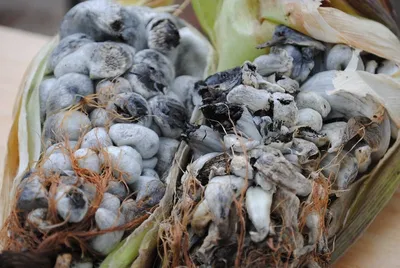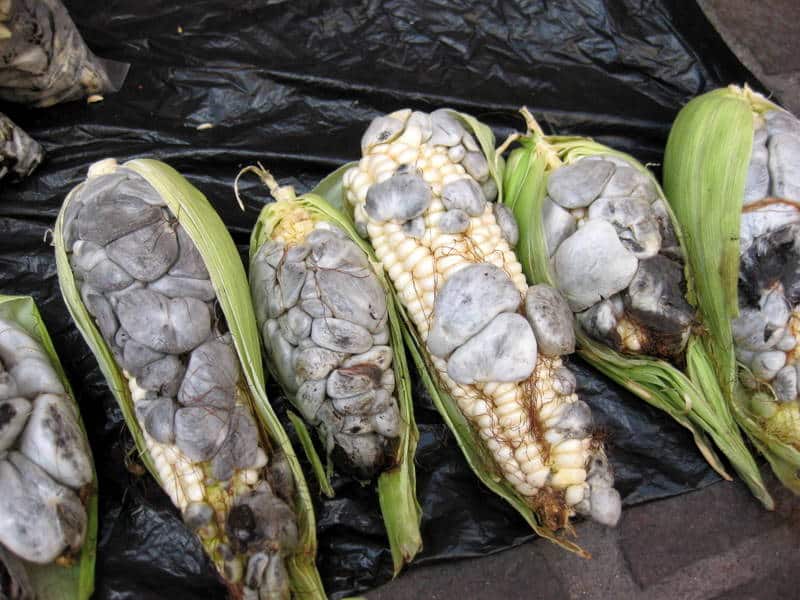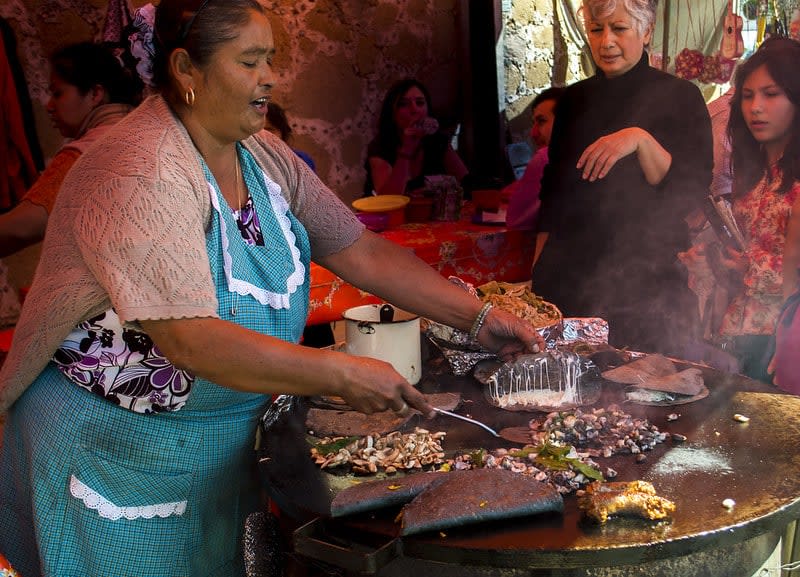
Huitlacoche: Journey into the Enigmatic World of Mexican Cuisine
Huitlacoche: Journey into the Enigmatic World of Mexican Cuisine
So what is Huitlacoche? I can imagine that the first time you read or hear its name, you find it difficult to pronounce.
Your reluctance increases when someone explains that it is a parasitic fungus, a pest that affects the corn cob.
But when you finally taste it, an explosion of intense, earthy, moist flavors overcomes your senses.
That’s when you discover why Huitlacoche is considered a delicacy in Mexico, where it is part of its cultural identity more than an ingredient.
While you may already be more familiar with other typical products of Mexican cuisine, such as avocado, chiles, tortillas, or even nopales (cactus), Huitlacoche remains a great unknown for the general public, and we rarely see it on a Tex-Mex menu.
You may want to read: What are Escamoles, and What Do They Taste Like?
However, if it appears prominently among the gastronomic offer of a restaurant, you can venture to affirm that it is a good sign.
What is Huitlacoche, and what is its origin?
Also called cuitlacoche, Huitlacoche is a pathogenic fungus that affects the corn cob, causing blight in the grain.
If you intend to cultivate corn cobs to harvest cereal, transform it into flour, or sell it fresh, it will be a severe pest, but in Mexico, the corn paradise, they have turned it into a blessing.
Huitlacoche feeds as a plant parasite, producing blackish or gray spores.
There are several etymological theories about the meaning of the name, although all of them refer to an Aztec Nahuatl origin.
Cabrera Lobato’s Dictionary of Aztecisms affirms that Huitlacoche is an erroneous derivative of the original cuitlacoche.
The true meaning of cuitlatl has been identified with a bird and an excrescence, which in both cases would be related to the form that acquires the infected cob.
Its appearance is certainly not very appetizing. The invaded cob looks toxic and inedible, almost like a deformed creature from science fiction.
What does this Mexican truffle look like?

What you see covering the corn kernels is a kind of plant tumor, galls that plants develop in response to external attacks in the form of abnormal tissue.
You may want to read: Chinicuiles and Mezcal Worms: The Kings of Edible Insects
When these galls are still young, they are harvested, separated from the cob, and used for culinary purposes, as they contain a dark mass of intense aromas and flavors.
The indigenous American peoples also attributed medicinal properties and ritual meanings to the Huitlacoche and culinary purposes.
Huitlacoche benefits
Traditional medicine has attributed beneficial properties to Huitlacoche.
Its energy content is low, with less than 100 kcal per 100 g of edible canned portion, but it is a very interesting food in terms of the nutrients it concentrates in small quantities.
According to several studies, Huitlacoche is rich in fiber and low in saturated fats and cholesterol, highlighting its contribution to healthy monounsaturated and polyunsaturated (linoleic) fatty acids.
It is rich in phosphorus and magnesium and contains, to a lesser extent, calcium and small amounts of iron and zinc.
Researchers highlight its antioxidant power due to the contribution of vitamin C and, above all, amino acids.
Where to find Huitlacoche
Nowadays, it is usual to produce selective crops with pest-resistant cornfields and productions destined to develop Huitlacoche.
The expansion of Mexican cuisine, thanks both to immigration and to the spread of its culture by great chefs, has led to its cultivation outside Mexico as well.
You can now order canned huitlacoche through Amazon.
Although Huitlacoche grows naturally in practically all corn plantations, its commercial exploitation is still scarce.
Only a handful of daring farmers are dedicated to producing it by cultivating corn exclusively to infect the cobs with huitlacoche spores.
However, even though it is scarce and difficult to find in commercial markets, its presence is already a constant feature in Mexican haute cuisine restaurants throughout the U.S. and the occasional market specializing in Mexican foods.
Most of the Huitlacoche consumed fresh in the United States is distributed by Woodland Foods, an agricultural company located in Waukegan, Illinois.
The company distributes it frozen, on demand, using courier companies to deliver it quickly by air.
What does Huitlacoche taste like?
Huitlacoche has been nicknamed The Mexican Truffle and Aztec caviar.
In addition to sharing its fungal nature, the flavor of Huitlacoche is strongly earthy and has a subtle corn aftertaste.
You may want to read: What is Salsa de Jumiles? Dare to Try These Sacred Insects
It is pure umami, reminiscent of the potency of mushrooms such as shiitake, the earthy aroma of black truffles, and the moistness of blue cheeses, with a slight reminiscence of cereal from the original corn.
Cooking it is very easy, especially if it is canned.
It is enough to sauté, stew, or mix directly with other ingredients without any previous preparation.
If used fresh, the grayish color will turn to dark black quickly as its structure is broken down and heated, and the soft, meaty texture is ideal for integrating and blending.
In the kitchen
Huitlacoche combines very well with other intense ingredients, such as cheeses and meats, hot spices, pickles, aromatic fresh herbs, or robust stews and soups.
The simplest and most common way to consume it is to enrich the filling of squash blossom quesadillas, tacos, tamales, empanadas, tostadas, or fajitas.
It also pairs deliciously well in egg-based preparations, such as omelets or simple scrambled eggs, as would mushrooms.
Huitlacoche and squash blossom quesadilla recipe

Huitlacoche & squash blossom quesadillas make a classic Mexican meal. They are delicious and very quick to prepare.
In Mexico, we usually go to the “garnachera’s” stall to buy a few quesadillas: cheese, picadillo, rajas, squash blossom, and Huitlacoche.
But sometimes you want to make them at home to surprise your friends or as a quick snack.
For that reason, I’ll share this huitlacoche quesadillas recipe you can make at home. Take note:
Ingredients for two servings:
- 200 gm huitlacoche
- A handful of squash blossoms
- 1/2 chopped onion
- Grated Oaxaca cheese
- Chopped epazote
- 1/3 cup corn kernels
- Salt and pepper to taste
- 6 Corn tortillas
- Vegetable oil
Process:
- In a non-stick frying pan, sauté the onion in vegetable oil until it changes color
- Add the corn kernels and squash blossoms and stir until cooked through and shiny
- Add the Huitlacoche and epazote, and season to taste with salt and pepper
- Cook the mixture for 10 minutes over low heat and remove it from the stove when most of the moisture has evaporated
- Heat the corn tortillas in a comal until the cheese melts, and fill them with the huitlacoche stew
Add the sauce of your choice. Enjoy!